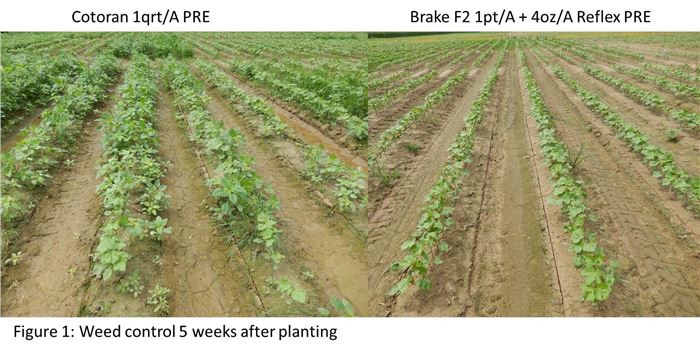Brake F2 Section 18 For Cotton
DR. TOM BARBER
LITTLE ROCK, ARK.
Over the last week I have had several questions about Brake F2 herbicide in cotton. This year Arkansas, Tennessee and Missouri all filed and received Section 18 emergency use exemptions for pre-plant or preemerge applications of Brake F2 in cotton. Brake F2 is a pre-mix combination of fluridone (Brake or Sonar) and fomesafen (Reflex) and provides 2 modes of action for control of glyphosate-resistant Palmer pigweed in cotton. The labeled rate ranges from 1 to 1.5 pt/A, but due to product expense and carryover issues, most recommendations will likely fall in the 1 pt/A range. One pint/Acre Brake F2 is equivalent to 0.2 lb ai/A fluridone (Brake) and 0.125 lb ai/A fomesafen (equivalent to 8 oz/A Reflex). Most cotton growers who have battled pigweed the last 10 years have included Reflex pre-plant in their weed control programs. The recommended rate for Reflex pre-plant in cotton is 16 oz or 1pt/A. At this rate Reflex provides excellent residual control of Palmer pigweed. Growers over the last couple of years have also experienced increased injury when applying Reflex pre-plant, especially when no rain was received prior to planting the cotton. The formulation of Brake F2 provides some safening effect on the fomesafen (Reflex) component and we have not seen the extent of injury with fomesafen in this formulation as we have with Reflex when applied as a PRE. This does not mean that injury will not occur. The safest way to apply this product would be pre-plant similar to current recommendations for Reflex, wait on a rain and then plant.
The Brake F2 premix combination with fluridone does add another mode of action, which is good for resistance management and can increase length of residual pigweed control, especially in wet years. Figure 1 below shows the advantage last year of Brake F2 + 4oz of Reflex over 1 qrt/A Cotoran. Last year we received 1 or 2 inches of rain a week and Cotoran did not last more than 2 weeks in most cases. Brake F2 will provide much better control in wet years like last year. Coincidentally, it also seems to take more rainfall to activate Brake F2. In our research plots the last couple of years, the fluridone component of Brake F2 has required more rainfall for activation than the fomesafen or Reflex component. In years where only 0.5 inches or less rainfall is received following application, the fluridone component may not be activated and in these situations, a half rate of Reflex is all that is preventing a flush of pigweed. For best results, and increased residual activity/protection from Palmer pigweed growers should consider spiking the 1pt/A Brake F2 with an additional 4oz/A Reflex to protect cotton in situations where minimal rainfall is received for activation.
Brake F2 appears to have a better fit on our sandy and silt loam soils more so than on soils high in clay content. Heavy clay soils will bind more with the Brake F2, resulting in reduced weed control activity. At the 1 pt/A rate of Brake F2, the plant-back interval to rotational crops are 8 months to soybean, and small grains including wheat; 10 months to peanut, rice, corn and sweet potato; 18 months to grain sorghum or sunflowers. If the Brake F2 rate is increased to 1.5 pt/A the corn re-plant interval is increased to 15 months.
I think Brake F2 will have a fit on many of our cotton acres to provide another tool for resistant-pigweed control. Producers should try this new product out on a few fields to see how it best fits their operation. This is not something to go across the farm with the first year. ∆
DR. TOM BARBER: Extension Weed Scientist, University of Arkansas
